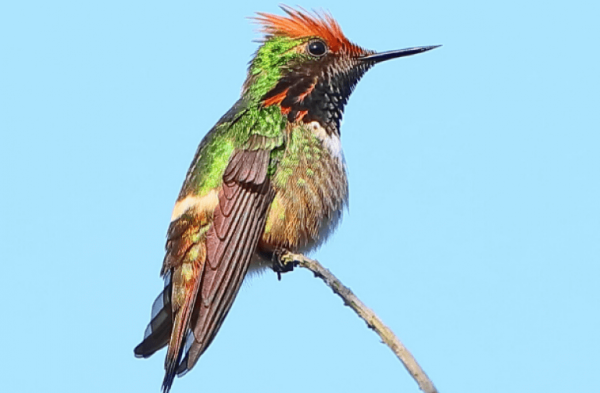
The critically endangered Short-crested Coquette in only found in the mountains of Guerrero, Mexico (photo by Greg Homel).
|
New field research reveals that critically endangered Short-crested Coquette hummingbirds inhabit more diverse habitats than previously thought. A team led by Dr. Carlos Almazan of the Autonomous University of Guerrero in southern Mexico found that these tiny hummingbirds, which have only been found in the Sierra de Atoyac mountains in the state of Guerrero also inhabit semi-deciduous forests with pine trees, and cloud forests with pines. This is the first time the coquettes have been detected in forests with pines, and new range locations for the species were discovered.
Researchers found coquettes at a number of locations within this rare hummingbird’s range at an Alliance for Zero Extinction (AZE) site. (The Short-crested Coquette is the reason the Sierra de Atoyac is included as an AZE site – a biodiversity conservation area with one or more extremely threatened species found nowhere else on Earth.) The team’s research will direct future conservation efforts to save the species and its habitats, actions that are urgently needed considering that Short-crested Coquettes are only known from one small area that is quickly being degraded.
With American Bird Conservancy (ABC) support, the Almazan team has been studying the coquettes as part of a research project to learn more about these hummingbirds’ ecology and distribution, and to reach out to local communities to involve them in the effort to conserve habitats the coquettes require.
A follow-up project will build on the hummingbird field work to engage with local communities who combine communal and individual land use under the traditional Mexican land tenure system. The hope is to get community involvement in providing voluntary protected areas that safeguard coquette habitats. This project, which includes both Almazan’s team and the local NGO Institute for the Management and Conservation of Biodiversity, will also work with communities to develop income-generating projects geared to provide them with financial sustainability, while reducing pressures on the habitats used by coquettes.
“It’s an ambitious project,” noted Amy Upgren, the ABC lead for the project. “But if we can partner with the communities to successfully create protected areas while fostering revenue-generating opportunities, the long-term prospects for both people and Short-crested Coquettes will be improved.”
The field research also led to another interesting biological discovery: The team observed that these diminutive hummingbirds pierce fruit with their bill to access nectar. “We are still learning a lot about the coquettes,” said Dr. Almazan, “and we look forward to continued collaboration with the American Bird Conservancy to study and conserve this important species.”
To refer to the original news release, you can access it at https://abcbirds.org/article/milestone/short-crested-coquette-novel-habitat